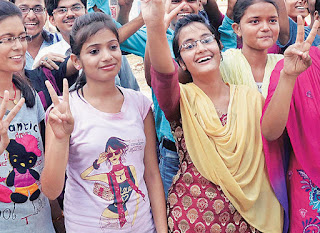How India’s digital revolution is changing the lives of talented students in small towns and villages
In the mid-80s, the Indian government launched a program to identify and provide free boarding & schooling to the talented children from the rural areas. The idea was that while the IITs and IIMs had developed as world-class institutions of higher education, they were often dominated by students from relatively privileged backgrounds.
Similarly, elite government and corporate jobs were restricted to those from the cities. This change, pioneered by the Ministry of Human Resource Development (MHRD), Govt. of India, came in the form of the Navodaya Vidyalaya Samiti, which began the Jawahar Navodaya Vidyalayas (JNVs), a system of alternate schools for gifted students in India from VI to XII standard. By many standards, the experiment has been a success.The JNV program was a major innovation with significant resources deployed - it is estimated that the MHRD spends Rs 85,000 annually on every student at JNV. The schools have produced many bright students and many of these return to their villages and are able to impact their villages positively. Examples include an ex JNV student who is now researching a cure for cancer in Malaysia.The academically elite schools for the poor were, in their time, a big idea and now are being transformed by technology. The goal is to not only make sure students from these schools have skills on par with the best private schools but also that they have a better understanding of concepts through new ways of seeing and learning.
In 2013, the Navodaya Vidyalaya Samiti partnered with Samsung to start the Smart Class initiative with the latest audio-visual tools for learning. Today the initiative is present in 398 JNVs across rural India and over 2 lakh students use the system. Tablets have been supplied to these classes along with interactive Smartboards, printers and other devices. The pedagogic methods have also changed as classrooms have become more interactive. Learning apps for Computer Science, Mathematics, English and Science have been created, and students are taught through interactive modules like videos, animation and presentations that enable them to learn in a quicker, deeper and more fulfilling manner.In the first three years, the initiative has seen some early successes. The story of Sadanand Ugale is one. Sadanand was a bright student studying in a remote village, Chinchada, in Maharashtra. His village teacher told his father to enrol him in a Jawahar Navodaya Vidyalaya in Kannad, Aurangabad district. With exposure to new-age education tools and modern pedagogical techniques, he was able to explore his potential.
His research on seasonal diseases was selected to be presented at the National School Congress in Bangalore. He then went on to get chosen by the International Science School (ISS), Sydney to present the research paper in Australia and was even awarded a scholarship. Today he is preparing for his SSC exams and dreams of becoming a doctor and returning to his village to make it a better place. His parents feel immense pride in his achievement and his desire to strive further and contribute to the community he came from. Another inspiring story is that of Ritwik Kumar from Bijnore who was afflicted with vision impairment. He studied in the Samsung Smart Class and through his grit and brilliance, got into an IIT. Similarly, Adesh Vaidya got selected by the HRD ministry to participate in a study tour in Japan. These are only a few of the children impacted by the use of technology and connectivity in the classroom. With greater penetration, this can bring significant change to the state of education as well as the lives of people.
The digital revolution shows the potential to be a great enabler for the change in this regard. The number of internet users in India grew by 49% in 2015, according to the IAMAI. Mobile internet users grew by over 65% in urban India in 2015, and by over 99% in rural India. While digital tools of education like iPads or video conferencing are gaining traction in middle to high-income groups in urban India, they are yet to penetrate rural India. But this is changing slowly, by the efforts of the government and some private players.Providing quality education to everyone regardless of where they come from is one of the biggest challenges India is facing today. This is a particularly large problem in rural areas that need to deal with challenges as varied as a lack of teaching facilities, unavailability of teachers and the financial inability of many parents to put their children through school. As a consequence, many students in rural India tend to experience disenchantment with education leading to high drop-out rates. In what becomes a vicious cycle, these children then go on to take up unskilled or semi-skilled jobs if they are boys or get married at a young age if they are girls. Many of them find it difficult to break out of the poverty trap.Perhaps the most significant and preventable problem here is that the process of learning in rural schools itself is not interesting. In the NFHS III Survey, “lack of interest” was cited as the main reason for dropping out of school for around 36% of boys and 21% of girls. So, digital teaching tools can not only change the way teachers instruct children - making learning more fun, interactive and interesting, but they also have the potential to bring children into the classroom and keep them from dropping out mid-way. Along with this, digital tools of learning like video conferencing and Wi-Fi enabled tablets can also provide children greater exposure and access to the world outside their physical reach and enable them to create wider networks, giving them opportunities they could never imagine before. In doing so, they can enable bright Indian children to showcase their abilities on a global platform. Like they did for Sadanand.





Post a Comment